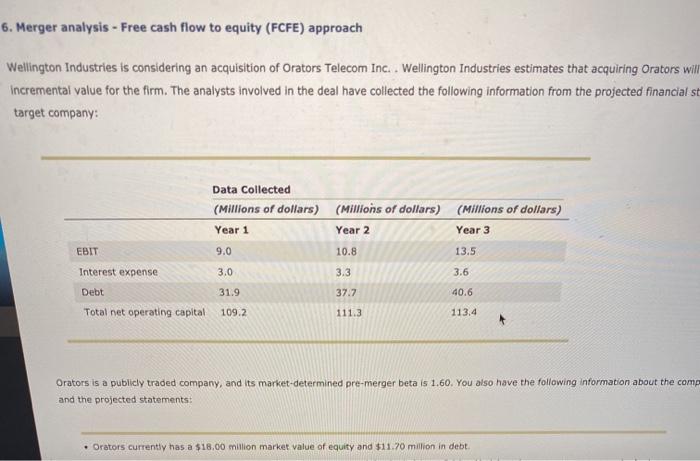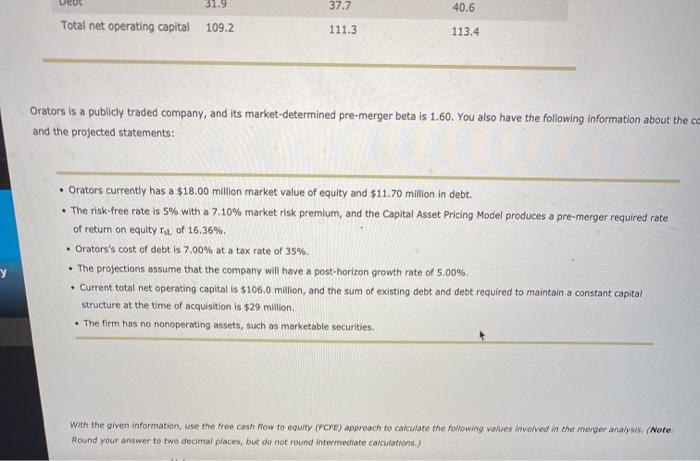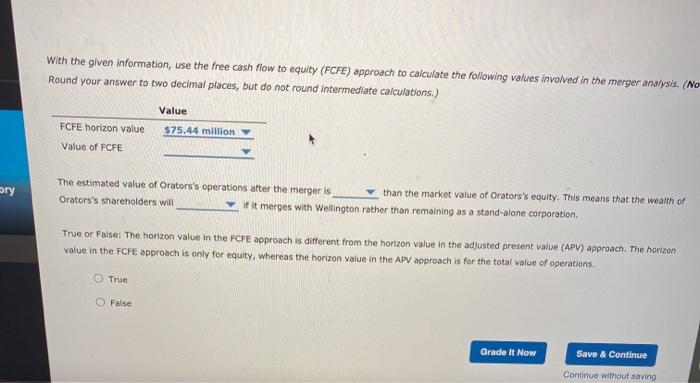31.9 37.7 40.6 Total net operating capital 109.2 111.3 113.4 Orators is a publicly traded company, and its market-determined pre-merger beta is 1.60. You also have the following information about the co and the projected statements: Orators currently has a $18.00 million market value of equity and $11.70 million in debt. The risk-free rate is 5% with a 7.10% market risk premium, and the Capital Asset Pricing Model produces a pre-merger required rate of return on equity of 16.36%. Orators's cost of debt is 7.00% at a tax rate of 35% . The projections assume that the company will have a post-horizon growth rate of 5.00% Current total net operating capital is $106.0 million, and the sum of existing debt and debt required to maintain a constant capital structure at the time of acquisition is $29 million The firm has no nonoperating assets, such as marketable securities. with the given information, use the free cash flow to equity (rore) approach to calculate the following values involved in the merger analysis. (Note Round your answer to two decimal places, but do not round intermediate calculations.) With the given information, use the free cash flow to equity (FCFE) approach to calculate the following values involved in the merger analysis. (No Round your answer to two decimal places, but do not round intermediate calculations.) Value FCFE horizon value $75.44 million Value of FCFE Bry The estimated value of Orators's operations after the merger is than the market value of Orators's equity. This means that the wealth of Orators's shareholders will Wit merges with Wellington rather than remaining as a stand-alone corporation True or False: The horizon value in the FCFE approach is different from the horizon value in the adjusted present value (APV) approach. The horizon value in the FCFE approach is only for equity, whereas the horizon value in the APV approach is for the total value of operations True False Grade It Now Save & Continue Continue without saving 31.9 37.7 40.6 Total net operating capital 109.2 111.3 113.4 Orators is a publicly traded company, and its market-determined pre-merger beta is 1.60. You also have the following information about the co and the projected statements: Orators currently has a $18.00 million market value of equity and $11.70 million in debt. The risk-free rate is 5% with a 7.10% market risk premium, and the Capital Asset Pricing Model produces a pre-merger required rate of return on equity of 16.36%. Orators's cost of debt is 7.00% at a tax rate of 35% . The projections assume that the company will have a post-horizon growth rate of 5.00% Current total net operating capital is $106.0 million, and the sum of existing debt and debt required to maintain a constant capital structure at the time of acquisition is $29 million The firm has no nonoperating assets, such as marketable securities. with the given information, use the free cash flow to equity (rore) approach to calculate the following values involved in the merger analysis. (Note Round your answer to two decimal places, but do not round intermediate calculations.) With the given information, use the free cash flow to equity (FCFE) approach to calculate the following values involved in the merger analysis. (No Round your answer to two decimal places, but do not round intermediate calculations.) Value FCFE horizon value $75.44 million Value of FCFE Bry The estimated value of Orators's operations after the merger is than the market value of Orators's equity. This means that the wealth of Orators's shareholders will Wit merges with Wellington rather than remaining as a stand-alone corporation True or False: The horizon value in the FCFE approach is different from the horizon value in the adjusted present value (APV) approach. The horizon value in the FCFE approach is only for equity, whereas the horizon value in the APV approach is for the total value of operations True False Grade It Now Save & Continue Continue without saving









